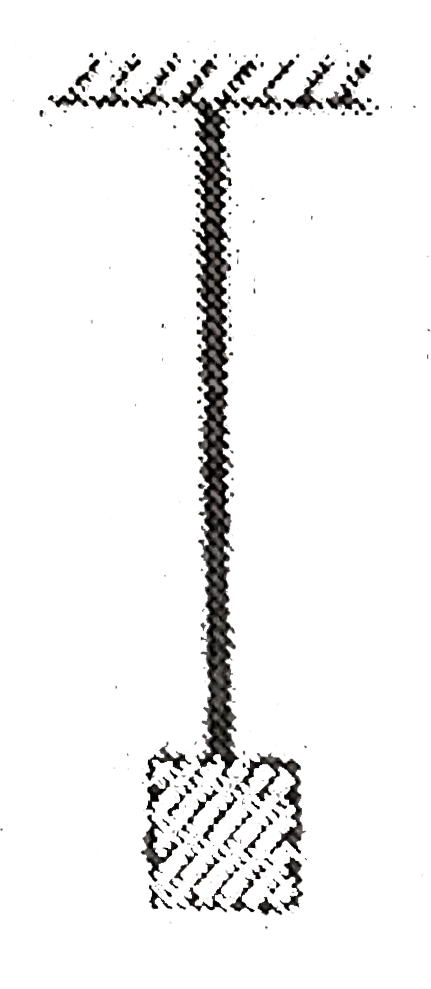A copper wire of negligible mass, length l and corss-section A is kept on a smooth horizontal tabel with one end fiexed. A ball of mass m is attached to the other end. The wire and the ball are rotating with an angular velocity ω. If elongation in the wire is Δl, obtain the expression for the Young's modulus.
When the ball attached at one end of wire is rotating, then the restoring force in the wire is equal to the centripetal force on the ball.
Centripetal force F=mrω2=m/ω2
As Y=FA×lΔlorF=YAΔll
∴YAΔll=m/ω2orY=ml2ω2AΔl.
Topper's Solved these Questions
- PROPERTIES OF BULK MATTERBOOK - PRADEEPCHAPTER - PROPERTIES OF BULK MATTEREXERCISE - Long Answer questions
33 Videos
- PROPERTIES OF BULK MATTERBOOK - PRADEEPCHAPTER - PROPERTIES OF BULK MATTEREXERCISE - Solved Examples
159 Videos
- PROPERTIES OF BULK MATTERBOOK - PRADEEPCHAPTER - PROPERTIES OF BULK MATTEREXERCISE - Very short answer questions
163 Videos
- PHYSICAL WORLD AND MEASUREMENTBOOK - PRADEEPCHAPTER - PHYSICAL WORLD AND MEASUREMENTEXERCISE - Competiton Focus Jee Medical Entrance
18 Videos
- RAY OPTICSBOOK - PRADEEPCHAPTER - RAY OPTICSEXERCISE - Problem For Practice(a)
25 Videos
Similar Questions
A copper wire of negligible mass, 1m length and cross-sectional area 106m2 is kept on a smooth horizontal table with one end fixed. A ball of mass 1kg is attached to the other end. The wire and the ball are rotating with an angular velocity of 20rad/s. If the elongation in the wire is 10−3m.
a. Find the Young's modulus of the wire (in terms of ×1011N/m2).
b. If for the same wire as stated above, the angular velocity is increased to 100rad/s and the wire breaks down, find the breaking stress (in terms of ×1010N/m2).
View SolutionA body of mass M is attached to the lower end of a metal wire, whose upper end is fixed . The elongation of the wire is l.
View Solution
Knowledge Check
A steel wire of negligible mass length L0 and cross sectional area A0 is kept on a smooth horizontal table with one end fixed. A ball of mass M is attached to the other end. The wire and ball are rotating with angular velocity ω . If elongation in the wire is ΔL, then the value of Young's modulus of elasticity will be
AML20ω2A0ΔLBMA0ω2L20ΔCML30ω2A0(ΔL)2Dnone of the aboveA copper wire of negligilble mas, length (l) and cross-sectional area (A) is kept on a smooth horizontal table with one end fixed, a ball of mass 'm' is attached at the other end. The wire and the ball are rotated with angular velocity 'ω'. If wire elongates by Δl then the Young's modulus of wire and if on incresing the angular velocity from ω to ω1 when the wire breaks-down, then the brekaing stress (Δl<<l) are respectivley.
A(ml2ω2)AΔl,mlω2ABmlAΔlω2,mlω2ACmlω2AΔl,mω2AlDmlω2AΔl,mlω2AlA metal wire of negligible mass, length 1 m and cross-sectional area 10−6m2 is kept on a smooth horizontal table with one end fixed on the table. A ball of mass 2kg is attached to the other end of the wire. When the wire and the ball are rotated with angular velocity of 20 rad/s, it is found that the wire is elongated by 10−3m. If the Young's modulus of the metal is n×1011N/m2, then the value of n is
A6B8C9D10
A sphere of mass m attached with the free end of a steel wire of length l swings in the veritical plane form the horizontal positon.

Elongation of the wire in the vericle positon is
View SolutionA uniform rod of length l, mass m, cross-sectional area A and Young's modulus Y is rotated in horizontal plane about a fixed vertical axis passing through one end, with a constant angular velocity ω. Find the total extension in the rod due to the tension produced in the rod.
View SolutionA metal wire of length L is suspended vertically from a rigid support. When a bob of mass M is attached to the lower end of wire, the elongation of the wire is l:
View SolutionA wire of length l, area of cross-section A and Young,s modulus of elasticity Y is suspended form the roof of a building. A block of mass m is attached at lower end of the wire. If the block is displaced from its mean position and released then the block starts oscillating. Time period of these oscillations will be

View SolutionA body of mass M is attached to lower end of a metal wire whose upper and is fixed. The elongation is l. The ratio of loss of gravitational potential energy to the energy stored in the wire is
View Solution
